A Christmas Story: Life in Ralphie’s World
(Editors note: The team from A Christmas Story National Tour provided an extensive study guide for teachers and students who might venture out to see the award-winning musical production. While not part of the official public press release, we found the study guide fascinating. The Baltimore Post-Examiner is offering a few highlights from the guide for the edification of our readers and as a whimsical reminder of the way things used to be. A Christmas Story: The Musical runs now through December11 at the Hippodrome Theatre in Baltimore, Maryland)
Life in Ralphie’s World
Although the year in which the movie takes place is not specifically stated, the year is probably 1940. This was just as the Great Depression was coming to an end and just before the United States entered World War II.
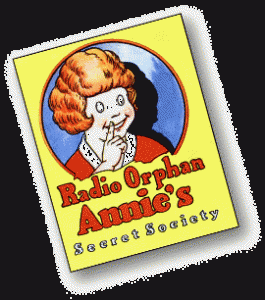
The world of Ralphie Parker in A Christmas Story is very different from life today. Televisions were very rare. Instead, radios and newspapers provided an information lifeline for Americans. Whole families gathered around the radio to listen to news broadcasts and popular programs like Little Orphan Annie, quiz shows, mysteries, dramas, music and sports. Here are just a few toys, popular items of the day, and historic events in Ralphie’s world.
Red Ryder BB Guns were the preference of Red Ryder, a fiction comic book cowboy in the 1940s. But the Red Ryder air gun, with its lever action, spring piston, smooth bore barrel, adjustable iron sights, and a gravity feed magazine with a 650 BB capacity was a real product and highly desired by many American boys. The Red Ryder “Range Model Carbine-Action BB Gun” in the movie was a fictional mode from Jean Shepherd’s imagination. It included a compass and “this thing that tells time” which were never a part of the Red Ryder BB Gun. The “Buck Jones” Daisy Air Rifle did have a compass and sundial in the stock and could have served as an inspiration.
Boy, It’s A Daisy!
The Daisy Air Rifle Company actually had its beginnings back in 1882, as the Plymouth Iron Windmill Company, a manufacturer of windmills in Plymouth, Michigan. However, by the 1880s, the windmill business was changing and the struggling company began looking for new ways to attract customers. In 1886, Plymouth inventor Clarence Hamilton introduced a new idea to the windmill company. It was a combination of metal and wire, vaguely resembling a gun that could fire a lead ball using compressed air. Lewis Cass Hough, then president of the firm, gave it a try and, after his first shot, enthusiastically exclaimed, “Boy, that’s a daisy!” The name stuck and the BB gun went into production as a premium item give to farmers when they purchased a windmill. The gun was such a huge success that Plymouth Iron Windmill soon began manufacturing the Daisy BB gun in place of windmills! On January 26, 1895, the company’s board of directors officially voted to change the name to Daisy Manufacturing Company, Inc.
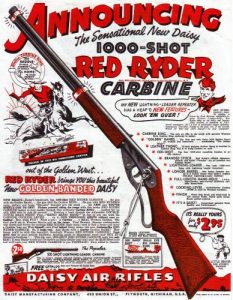
The sturdy little Daisy BB gun quickly became a staple with American youth. Youngsters all across the land cut their shooting teeth on a Daisy. Competition was keen at the time, with guns such as Bulls Eye, Dewey, Hero, Dandy, Atlas and others appearing almost overnight and disappearing just as quickly. Over the years, Daisy has continued to improve and expand their line of airguns, putting model after model within the reach of every young shooter’s pocketbook and skill level.
In 1958, Daisy moved their offices and manufacturing facilities from Plymouth to Rogers, Arkansas, where the company continued to prosper and grow. One gun, more than any other, played a major role in making Daisy the household name it is today. Introduced in 1939, the Daisy Red Ryder sold more than 9 million units, easily making it the most famous BB gun ever built! Today, Daisy has become a household word, selling guns in almost every country and on five continents.
The Little Orphan Annie Show was one of the first 15-minute daily radio serials made for children. The show was sponsored by Ovaltine and ran from 1930 to the early 1940s. It was inspired by the daily American comic strip by Harold Gray about a young orphan girl, her dog Sandy, and her guardian, Daddy Warbucks. They encounter many adventures including gangsters, spies, and kidnappers. The show was also known for its opening theme song sung by Pierre Andre.
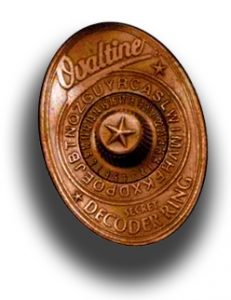
Ovaltine is a brand of milk flavoring created in 1904 in Switzerland and is still available today. The powdery mix, made of sugar, malt extract, cocoa, and whey, is often mixed with warm or hot milk. As a sponsor for The Little Orphan Annie Show, Ovaltine offered Secret Decoder Rings in exchange for proofs of purchase.
Decoder Rings were all the rage during the golden age of radio, lending an air of participation to popular radio shows like the Little Orphan Annie Show.
Shirley Temple Dolls were manufactured by Ideal Toys and Novelty Company and were fashioned after Shirley Temple, the child star known for films such as Bright Eyes, Heidi, and The Little Princess.
Lionel Trains were electric toy trains and model railroads that were embellished with hand-painted details and authentic elements. Elaborate train displays were often featured as part of department store Christmas displays and a Lionel Train Set was routinely found under the tree on Christmas morning.
Open Road for Boys was a popular boy’s outdoor adventure fiction magazine from 1919 to 1950 that featured advertisements for model airplanes and Red Ryder products.
Jujubes are a candy drop created in 1920 that are still available today. Originally, it was a hard candy that you had to suck on and the original flavors were lilac, violet, rose, spearmint and lemon.
The Movies
Ralphie may have read books like Daniel Boone and Make Way for Ducklings, but one of the most popular forms of entertainment was at the local movie house where he might have seen National Velvet, Lassie Come Home, Flash Gordon, Roy Rogers and Superman. Ralphie could go to see a double feature, with newsreels and a cartoon plus a candy bar for only a dime!
Radio Flyer
Radio Flyer is a brand of toy wagons and sleds that are still popular today.
The Radio Flyer Company was founded in 1920 by Antonio Pasin when he began his business by making wagons at night in his little woodworking shop and selling them by day.
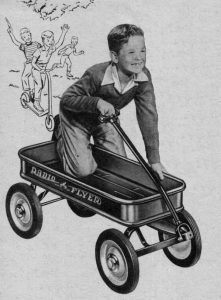
During the 20s, using the auto industry as inspiration, Pasin began using metal stamping technology to produce steel wagons and applied mass production techniques to wagon making. These innovations earned Pasin the nickname, “Little Ford.” To date, Radio Flyer is the #1 wagon maker in the world.
From 1942 – 1945, Radio Flyer was asked to stop wagon production and focus all its manufacturing effort on making five-gallon steel “blitz cans,” used to transport fuel and water during the war. On July 14, 1945, Radio Flyer was awarded the Army-Navy “E” Award, for high achievement in producing materials needed for the war.
In 2003, Antonio Pasin was honored by becoming the 44th toy innovator inducted into the Toy Industry Hall of Fame.
Zeppelin
Randy falls asleep under the Christmas tree with a toy Zeppelin or airship in his arms. A Zeppelin is a type of rigid airship pioneered by the German Count Ferdinand von Zeppelin in the early 20th century. Given the outstanding success of the Zeppelin design, the term “Zeppelin” in casual use came to refer to all rigid airships. Zeppelins were operated by the Deutsche Luftschiffahrts-AG (DELAG), the first commercial airline, and served scheduled flights before World War I. After the outbreak of the war, the German military made extensive use of Zeppelins as bombers and scouts.
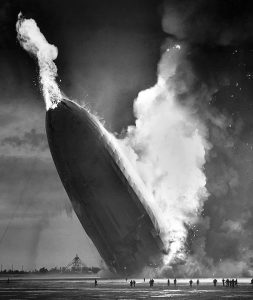
The World War I defeat of Germany in 1918 halted the airship business temporarily. But under the guidance of Hugo Eckener, the deceased count’s successor, civilian Zeppelins became popular in the 1920s. Their heyday was during the 1930s when the airships LZ 127 Graf Zeppelin and LZ 129 Hindenburg operated regular transatlantic flights from Germany to North America and Brazil. The Art Deco spire of the Empire State Building was originally (if impractically) designed to serve as a dirigible terminal for Zeppelins and other airships to dock. The Hindenburg disaster in 1937, along with political and economic issues, hastened the demise of the Zeppelin.
The Hindenburg was an airship that was the center of a disaster that took place on Thursday, May 6, 1937, as the German passenger airship caught fire and was destroyed during its attempt to dock with its mooring mast at the Lakehurst Naval Air Station, located near the borough of Lakehurst, New Jersey. Of the 97 passengers on board (36 passengers, 61 crew), there were 35 fatalities as well as one ground crew death. The disaster was the subject of spectacular newsreel coverage, photographs, and Herbert Morrison’s famous recorded radio eyewitness report from the landing field, which was broadcast the next day. The actual cause of the fire remains unknown, although a variety of hypotheses have been put forward for both the cause of ignition and the initial fuel for the ensuing fire. The incident shattered public confidence in the giant, passenger-carrying, rigid airship and marked the end of the airship era.
* * * * *
A Christmas Story: The Musical runs now – December 11 at The Hippodrome Theatre at The France-Merrick Performing Arts Center . The theater is located at 12 North Eutaw Street, Baltimore, Maryland. Tickets and other information may be found by visiting the Hippodrome online or by calling the box office at 410-837-7400.
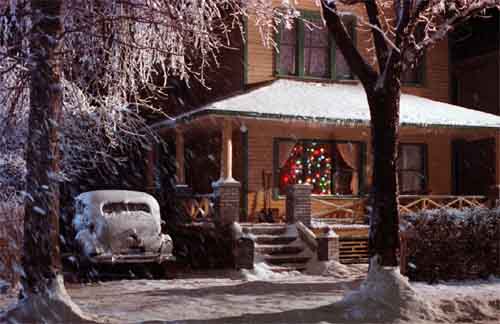

Baltimore Post-Examiner is run by a creative cadre of dedicated journalists – some who worked at the Washington Post, Baltimore Examiner and other regional and national publications. It’s the Post-Examiner because we love the play on the word “Post” but we are also hoping to answer that question: What’s next after newspapers? We see a lot of websites come and go – and many simply are not making it for various reasons. We have been a model of success since we launched in 2012 with “a little bit of everything” and we aim to continue to break that cycle of websites coming and going.
